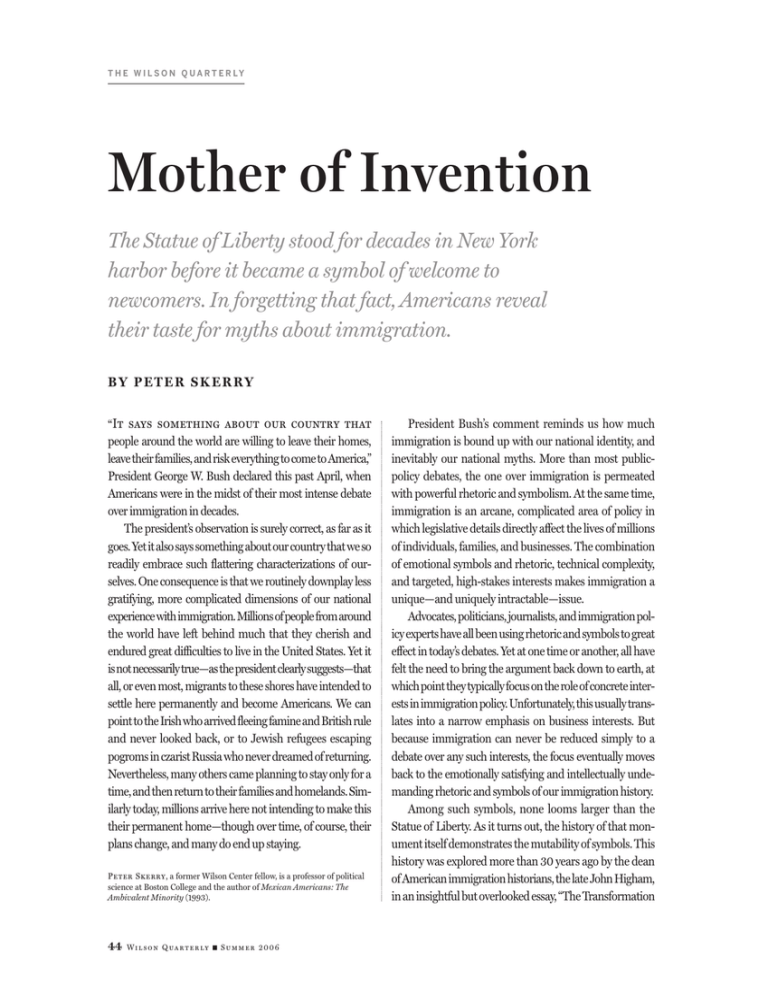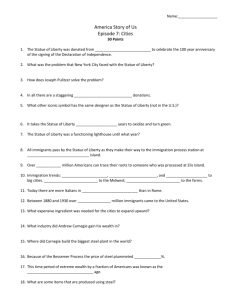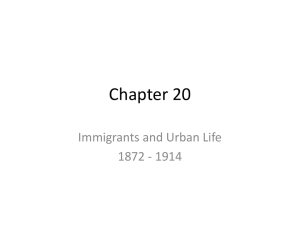Mother of Invention
advertisement

T H E W I L S O N Q U A R T E R LY Mother of Invention The Statue of Liberty stood for decades in New York harbor before it became a symbol of welcome to newcomers. In forgetting that fact, Americans reveal their taste for myths about immigration. BY PETER SKERRY “It says something about our country that people around the world are willing to leave their homes, leave their families, and risk everything to come to America,” President George W. Bush declared this past April, when Americans were in the midst of their most intense debate over immigration in decades. The president’s observation is surely correct, as far as it goes. Yet it also says something about our country that we so readily embrace such flattering characterizations of ourselves. One consequence is that we routinely downplay less gratifying, more complicated dimensions of our national experience with immigration. Millions of people from around the world have left behind much that they cherish and endured great difficulties to live in the United States. Yet it is not necessarily true—as the president clearly suggests—that all, or even most, migrants to these shores have intended to settle here permanently and become Americans. We can point to the Irish who arrived fleeing famine and British rule and never looked back, or to Jewish refugees escaping pogroms in czarist Russia who never dreamed of returning. Nevertheless, many others came planning to stay only for a time, and then return to their families and homelands. Similarly today, millions arrive here not intending to make this their permanent home—though over time, of course, their plans change, and many do end up staying. Peter Skerry, a former Wilson Center fellow, is a professor of political science at Boston College and the author of Mexican Americans: The Ambivalent Minority (1993). 44 Wi l s o n Q ua r t e r l y ■ S u m m e r 2 0 0 6 President Bush’s comment reminds us how much immigration is bound up with our national identity, and inevitably our national myths. More than most publicpolicy debates, the one over immigration is permeated with powerful rhetoric and symbolism. At the same time, immigration is an arcane, complicated area of policy in which legislative details directly affect the lives of millions of individuals, families, and businesses. The combination of emotional symbols and rhetoric, technical complexity, and targeted, high-stakes interests makes immigration a unique—and uniquely intractable—issue. Advocates, politicians, journalists, and immigration policy experts have all been using rhetoric and symbols to great effect in today’s debates. Yet at one time or another, all have felt the need to bring the argument back down to earth, at which point they typically focus on the role of concrete interests in immigration policy. Unfortunately, this usually translates into a narrow emphasis on business interests. But because immigration can never be reduced simply to a debate over any such interests, the focus eventually moves back to the emotionally satisfying and intellectually undemanding rhetoric and symbols of our immigration history. Among such symbols, none looms larger than the Statue of Liberty. As it turns out, the history of that monument itself demonstrates the mutability of symbols. This history was explored more than 30 years ago by the dean of American immigration historians, the late John Higham, in an insightful but overlooked essay, “The Transformation Immigration of the Statue of Liberty,” in a remarkable collection of his articles titled Send These to Me (1975). As every schoolchild knows (or at least used to know), the statue was a gift from France to the United States. Intended to commemorate French support of our war for independence, Liberty— actually, only her raised arm holding the torch—made her first appearance at the Philadelphia Exposition of 1876. The sculptor, Frédéric Auguste Bartholdi, was part of a circle of French liberals who conceived of Liberty as a gift from the French people to their republican brothers and sisters across the Atlantic. One consequence, as historian David Hackett Fischer points out, was that its cost was underwritten not by the French state but by private subscription and lottery. More to the point, Liberty was depicted as a woman whose austere, classical demeanor was meant to suggest the universality of America’s founding ideals. These were underscored by the tablets of law that she cradles in one arm and the torch she holds high with the other. And with her back to New York, Liberty strides oceanward, sending her light out into the world. Thus, at its origins the Statue of Liberty had nothing to do with immigration. It was intended as a beacon of hope to those struggling for liberty in their own lands, not as a welcome light for those seeking liberty here. As Higham points out, when the statue was unveiled on its completed pedestal in New York Harbor in 1886, the dignitaries’ inaugural speeches “concentrated almost exclusively on two subjects: the beneficent effect on other countries of American ideas, and the desirability of international friendship and peace.” “Liberty Enlightening the World”was the official name its French donors gave the Statue of Liberty. It is shown here under assembly in France three years before its 1886 dedication in New York. S u m m e r 2 0 0 6 ■ Wi l s o n Q ua r t e r l y 45 Immigration Yet even before the statue was in place, its transformation into a symbol of welcome to immigrants from around the world had subtly begun. In 1883, with the statue almost completed but the pedestal only half finished, the private Pedestal Fund Committee sponsored an art auction to raise desperately needed funds. Among the items auctioned off was the manuscript of a sonnet inspired by the statue, “The New Colossus,” by Emma Lazarus. The daughter of a wealthy New York sugar refiner, Lazarus was a secular, assimilated Jew. But in the early 1880s, as Jews fleeing pogroms in Russia began to arrive in New York, she became a champion of her people. And thus began the rein- The New Colossus Not like the brazen giant of Greek fame, With conquering limbs astride from land to land; Here at our sea-washed, sunset gates shall stand A mighty woman with a torch, whose flame Is the imprisoned lightning, and her name Mother of Exiles. From her beacon-hand Glows world-wide welcome; her mild eyes command The air-bridged harbor that twin cities frame. “Keep ancient lands, your storied pomp!” cries she With silent lips. “Give me your tired, your poor, Your huddled masses yearning to breathe free, The wretched refuse of your teeming shore. Send these, the homeless, tempest-tost to me, I lift my lamp beside the golden door!” —Emma Lazarus terpretation of the Statue of Liberty into a symbol not merely of welcome to immigrants but, more specifically, of refuge to those fleeing persecution and oppression. Still, Lazarus’s sonnet remained in obscurity for more than half a century. At Liberty’s inauguration, the poem went completely ignored. Twenty years after the auction, in 1903, a friend and admirer of Lazarus had her words engraved on a bronze tablet, but it was placed on an outof-the-way interior wall of the pedestal. Through most of the 1930s, the statue remained nothing more than a symbol, as Higham writes, of “Franco-American friendship and liberty as an abstract idea.” Even when President Franklin Roosevelt celebrated the 50th anniversary of the statue in 1936, he failed to mention Lazarus’s sonnet. Yet throughout this period, immigrants were arriv- 46 Wi l s o n Q ua r t e r l y ■ S u m m e r 2 0 0 6 ing in New York Harbor and passing by Liberty on their way to nearby Ellis Island. The emotional impact of that scene—whatever immigrants’ motives for coming here—fueled the symbolic transformation begun by Lazarus’s still-unknown poem. In Higham’s words, the immigrants saw Liberty “not as a beacon to other lands but as a redemptive salutation to themselves.” This remained only immigrant folklore, however—nothing more than an unofficial interpretation. But then, thanks to the tireless efforts of SlovenianAmerican journalist Louis Adamic, the immigrants’ emotional responses to the statue became truly part of the national consciousness. Starting in the late 1930s, Adamic’s countless articles and lectures about immigrants invariably quoted from “The New Colossus.” During World War II, the sonnet was set to music and received even more attention. In 1945, the bronze tablet of 1903 was moved from its obscure location to Liberty’s main entrance. The event that most decisively brought Lazarus’s sonnet to the attention of the American public was the plight of Jewish refugees in Nazi-dominated Europe. This was, of course, reminiscent of the situation that had so moved Lazarus more than 50 years earlier. Yet this time the association of the Statue of Liberty with refugees and victims of oppression generally stuck. In 1965, President Lyndon Johnson signed a historic immigration reform law in a ceremony at the base of the statue, and he cited Lazarus’s poem, using the occasion to announce a new program to aid refugees from Castro’s Cuba. This understanding of America as a haven for those seeking liberty is not incorrect. As Higham notes, “The concept of America as a refuge from European oppression supplied one of the original, fertilizing elements of our national consciousness.” But focusing exclusively on this one aspect of our immigration history hinders a fuller understanding of the complicated motivations of immigrants to these shores. For example, contrary to Lazarus’s stirring phrase about “Your huddled masses yearning to breathe free,” many immigrants have come to the United States not on account of lofty aspirations for political freedom but because of much more mundane appetites for economic security and advancement. Obviously, these two motives are not unrelated. But they are distinct and should not be so readily confounded. Another source of confusion has been Lazarus’s language about “your tired, your poor . . . The wretched refuse of your teeming shore.” Historian Josef Barton, among others, has pointed out that immigrants to America in the past Immigration were typically people with at least some modest means to plan ahead and pay for transatlantic passage. The most deprived and downtrodden in any society are the least likely to be able to do that. Perhaps most difficult to absorb is the fact that immigrants have often planned not to settle here permanently. Labor economist Michael Piore reminds us that in the period leading up to World War I, about one-third the number arriving from Europe returned home. The emigration rates for specific southern and eastern European nationalities (with the notable exception of Jews) were significantly higher. And none of the historical statistics captures the presumably even larger numbers of immigrants who arrived in the United States planning to return home but failed to do so. Today similar patterns are evident, especially among Mexican immigrants. Princeton sociologist Douglas Massey has documented that it is not the most destitute who migrate north to the United States, but rather those with a modicum of education and resources. Indeed, Massey argues that Americans’ perceptions of Mexico generally are distorted, pointing out that it is not exactly the poor, underdeveloped country we assume. He acknowledges the gap between America’s per capita income ($36,300) and Mexico’s ($8,900), but contrasts Mexico’s standing with the Congo’s ($600), emphasizing Mexico’s rough equivalence to Russia, with a per capita income of $9,700. And in terms of life expectancy, Mexico surpasses Russia—72.3 versus 67.7 years. The evidence is that many immigrants arrive in the United States today intending to return home. Massey’s research on Mexican migrants demonstrates this intention among many legal as well as illegal immigrants. The journey to El Norte typically reflects a conscious plan to maximize income, minimize expenditures, and return with enough money to start a business or, especially, build a house. Anthropologist Leo Chavez calls such immigrants “target earners,” people who come with specific savings goals that they meet by enduring many hardships—including long hours at dangerous jobs and substandard, overcrowded living conditions. To be sure, such plans change, and many immigrants put down roots here and stay. But that process is gradual, and the original intention of returning home has enduring effects. For example, it helps to explain why school districts in the Southwest with large immigrant populations empty out for weeks at a time in the winter, when Mexican families return home for the holidays. It also may explain why many immigrants do not place as much emphasis on learning English as they otherwise might. Or why many feel conflicted about assimilating into American society and are reluctant to let go of their native culture. Finally, such ambivalence might well explain why immigrants do not always seem as grateful to be here as Americans would like. I mmigration is often not the dramatic, single-momentin-time event we think of when we envision immigrants sailing past the Statue of Liberty. It is a complicated, drawn-out process, subject to diverse and contradictory pressures. Instead of being surprised or offended by immigrants’ failure to meet our ill-informed and romanticized expectations, we Americans should think about what we might do to clarify the many choices immigrants must make once they arrive. We could be much more explicit about what we expect of them, while at the same time doing much more to help them meet those expectations. Instead of arguing about bilingual ballots and education, for example, we could focus our energy and resources on developing better English-language programs. In effect, we need a greater dose of realism in our thinking about immigration. A good place to begin is with Reinhold Niebuhr’s The Irony of American History (1952), in which he carefully distinguishes among pathos, tragedy, and irony. Pathos elicits pity because it emerges when humans are overwhelmed by circumstances and are effectively denied choice. In contrast, tragedy provokes admiration because it involves the conscious choice of evil for the sake of good. Irony is more complicated—and compelling. It arises when contradictory or inconsistent reasons for our actions remain hidden from our understanding. Niebuhr emphasized that irony, unlike pathos, involves responsibility. Yet unlike tragedy, it does not involve full consciousness of choices being made. Ironic tension can be resolved only when individuals—or nations—come to a truer understanding of themselves. Niebuhr counseled Americans to move beyond irony, to see through the illusions and pretensions to which our unique history and power have made us particularly susceptible. In a similar way, the American debate over immigration would benefit from more self-conscious scrutiny of the beloved symbols and rhetoric that distort our understanding of this critical dimension of our national life. ■ S u m m e r 2 0 0 6 ■ Wi l s o n Q ua r t e r l y 47







